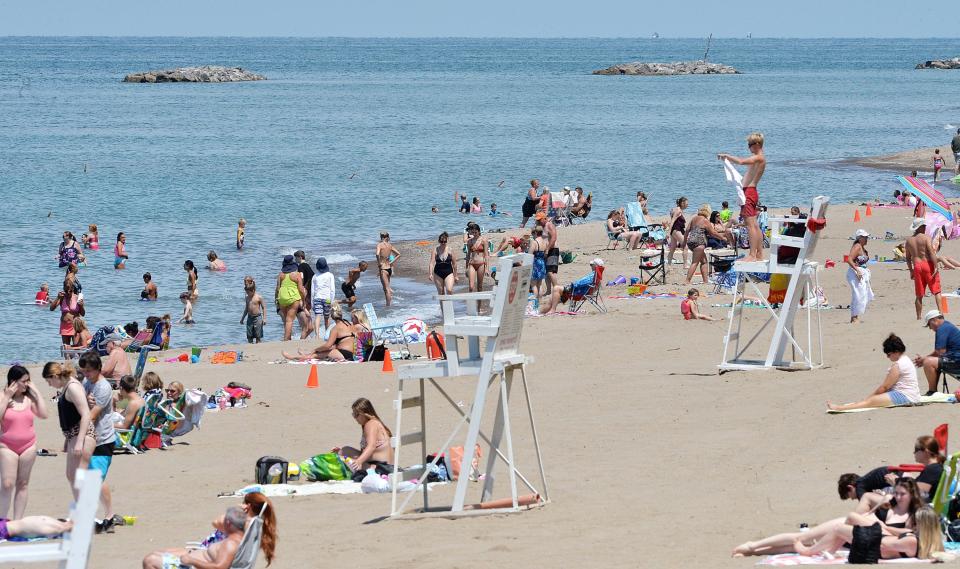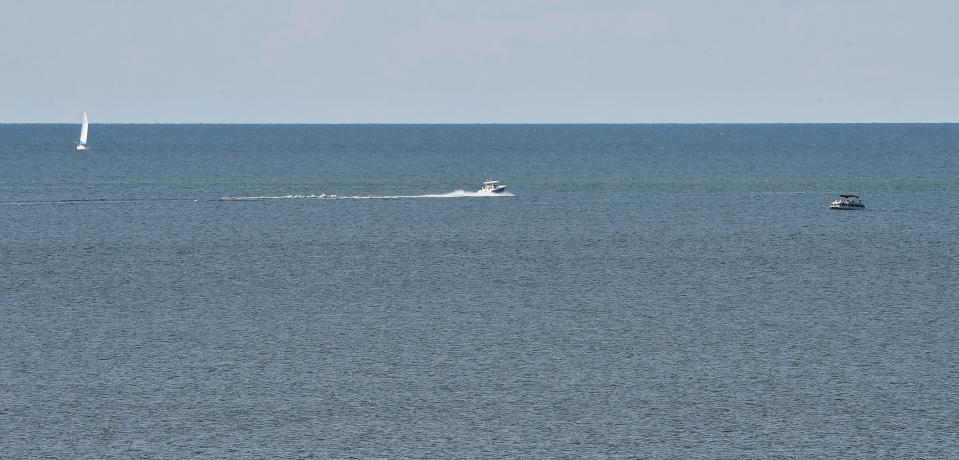A welcome sight: Lake Erie water level resuming seasonal decline but still above average
While Lake Erie's water level remains above average, it was expected to resume its seasonal decline in August and was projected to go down 5 inches between Aug. 11 and Sept. 11.
The downward trend is expected to continue through the end of the year and into 2024, according to information from the U.S. Army Corps of Engineers.
Such a drop at this time of year isn't unusual or unwelcome. Even though the lake didn't reach record highs in 2023, any kind of decline that takes levels closer to average can be beneficial for lakeshore property owners and places like Presque Isle State Park, located on a peninsula between Lake Erie and Presque Isle Bay.
"When the water goes down, there's less chance for erosion," said Matt Greene, park operations manager at Presque Isle.
He said as the water level drops, the peninsula's shore suffers less damage from autumn storms.

The Corps of Engineers' weekly Great Lakes water level update for Aug. 11 indicated that Lake Erie, forecasted to be at 572.77 feet on Aug. 11, would likely go down 5 inches within a month. The other four Great Lakes also are expected to drop during that timeframe: 1 inch for Lake Superior, 2 inches for Lake Michigan-Huron and 8 inches for Lake Ontario. Lake Michigan and Lake Huron are considered one lake for Army Corps forecasting purposes because the lakes are connected at the Straits of Mackinac and rise and fall together.
A July 2023 Great Lakes water level summary from the Corps said Lake Erie water levels are forecast to be 7 to 10 inches above long-term average levels through January but 18 to 27 inches below record-high levels. The highs were set in 1986, 1987, 2019 and 2020.
The lake’s water levels are expected to be 1 to 3 inches below 2022 levels from September to November and in January, according to the summary. In August and December, the forecast is for water levels to match 2022 levels.
Environment: Erie Coke contaminants found to have 'adversely affected' Lake Erie
Greene said Presque Isle experiences fluctuations in the Lake Erie level every season. It usually peaks in summer and reaches its low in December or January, going back up again with the spring rains.
Lake Erie had already started its seasonal water level decline from May to June, according to the Corps of Engineers summary. But that leveled off in July when the lake received above average water supplies, likely due to above average precipitation and runoff, according to the Corps of Engineers. The six-month forecast indicated the seasonal decline would continue in August.
For Lake Erie, the maximum water level recorded for July was 574.57 in 2019 and the minimum for July was 569.06 in 1934. For August, the maximum was 574.21 in 2019 and the minimum, 569 in 1934. The maximum for September was 573.72 in 2019 and the minimum for September was 568.83 in 1934, according to Corps of Engineers information.

Lake Erie reached its highest level, 574.61 feet, in June 2019, according to Army Corps of Engineers records. The monthly mean record highs for Lake Erie were set in October, November and December of 1986; January of 1987; June, July, August and September of 2019; and February, March, April and May of 2020.
Greene said the increasing cycle of lower water since those 2020 highs will eventually bottom out. Then low water levels could become an issue within a few years. He said low water was an issue around 2012, before he became manager at Presque Isle.
![Matt Greene, operations manager for Presque Isle State Park, is shown May 22 at the Tom Ridge Environmental Center. [JACK HANRAHAN/ERIE TIMES-NEWS]](https://s.yimg.com/ny/api/res/1.2/BKXd97rOEhjmmk71vDvPzQ--/YXBwaWQ9aGlnaGxhbmRlcjt3PTk2MDtoPTY5Ng--/https://media.zenfs.com/en/erie-times-news/0d7bfdbc50e2e0ef56b7da44a47f3035)
Officials in a March 2013 Erie Times-News story said the mild winter of 2011-12 and the dry summer of 2012 didn't provide what was needed to keep water levels up in the Great Lakes.
However, even that wasn't the low point for Lake Erie. The lake hit its lowest recorded water level, 568.18 feet, in February 1936, according to Corps records. Most of the lows for the other months were set in 1934.
Greene said a benefit of the continual fluctuation is change in what visitors to Presque Isle see. As water levels go down and parts of the peninsula become drier, seed banks get activated and plants that were previously covered by high water begin to grow again.
Outdoors: Walleye action heats up on Lake Erie. Here's how to catch the big ones
Like Lake Erie, the other Great Lakes are expected to be above their long-term averages but below record highs for the next six months, according to the July Corps of Engineers summary. Lake Ontario is an exception.
Lake Superior is projected to be 2 to 6 inches above long-term average levels and 7 to 13 inches below record high levels.
Lake Michigan-Huron is expected to be 4 to 5 inches above average levels and 29 to 36 inches below record highs.
Lake Ontario is projected to be 1 to 6 inches above long-term levels from August to November but then 1 to 2 inches below long-term average levels in December and January. The lake levels are forecast to be 21 to 27 inches below record high levels over the next six months.
Dana Massing can be reached at dmassing@timesnews.com.
This article originally appeared on Erie Times-News: Lake Erie water level declining but remains above average

